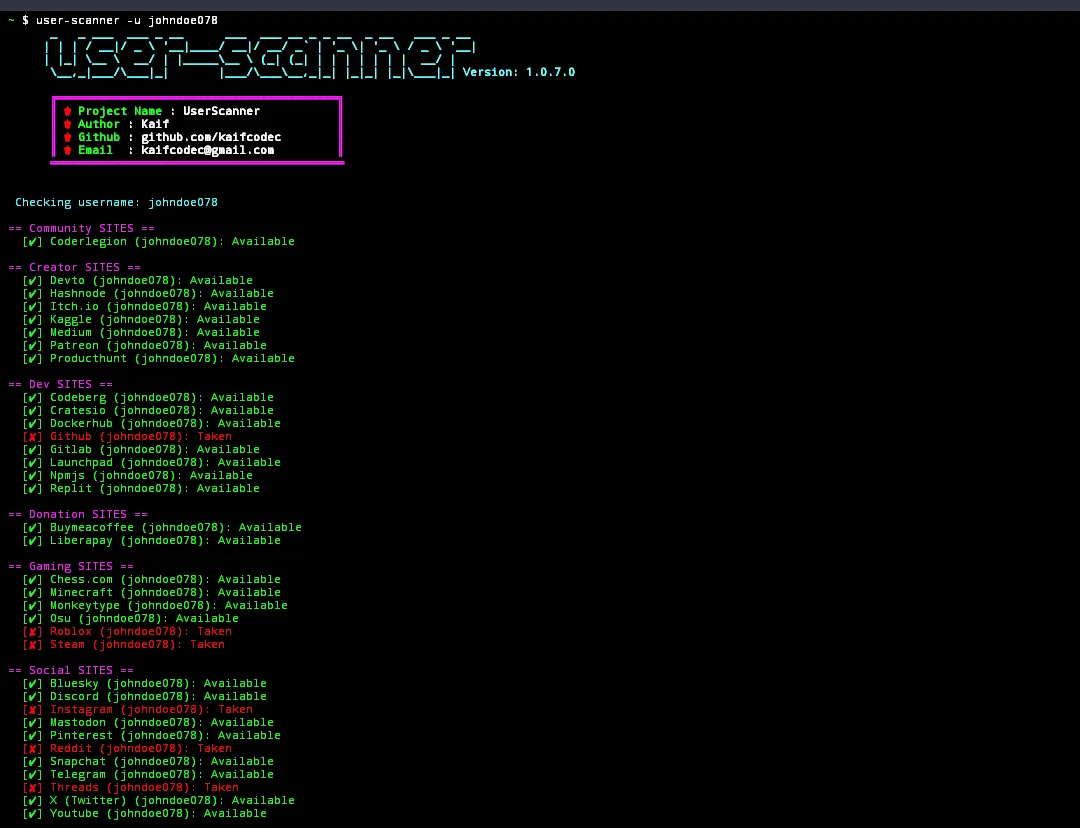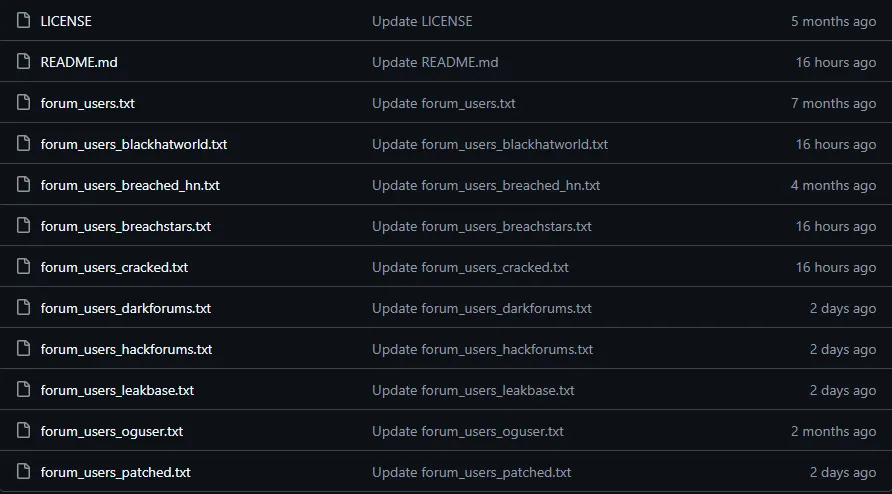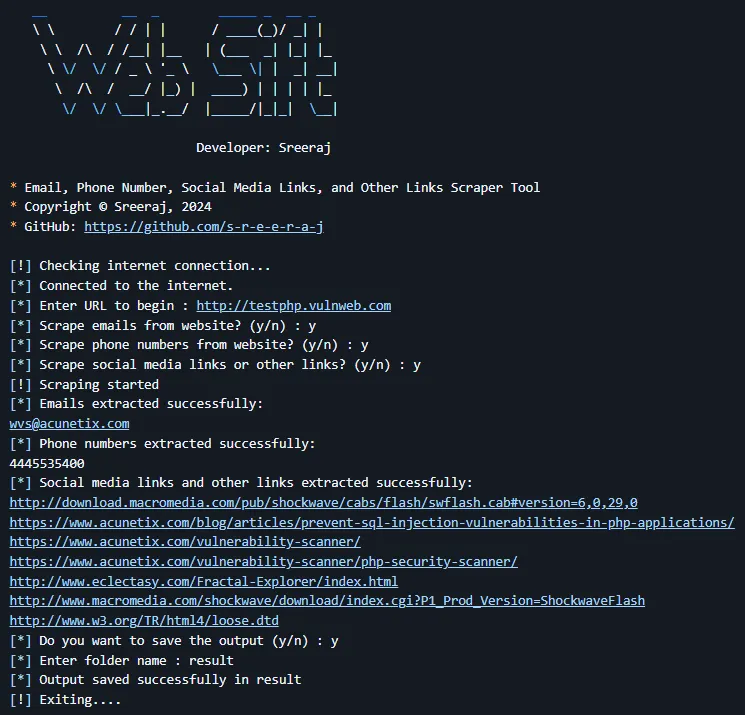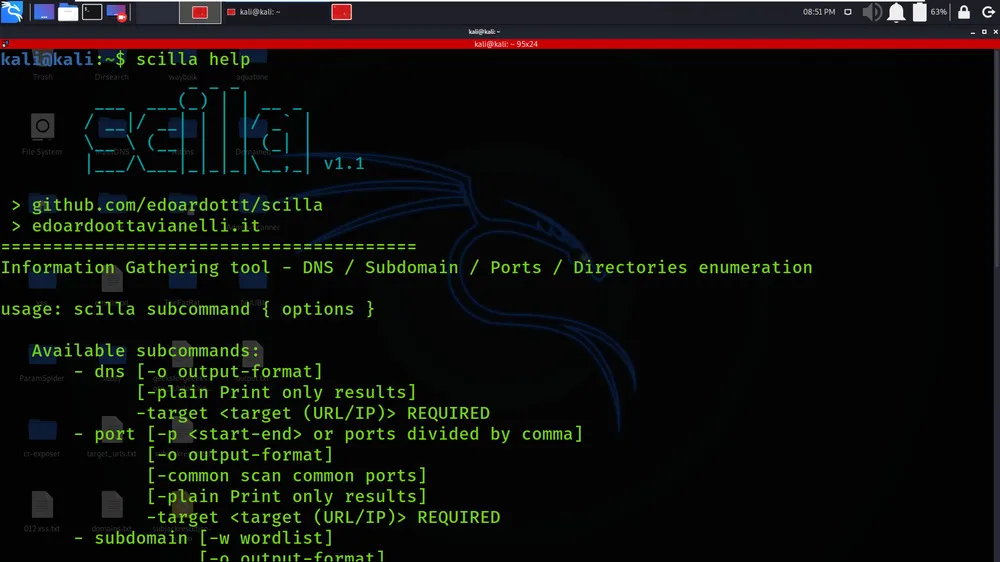Direct Link: https://github.com/yogeshojha/rengine
Last Commit: August 13th, 2024
reNgine 2.1.0 is released!
Unleash the power of LLM toolkit! Now you can use local LLM models to generate attack surface and vulnerability reports!, Checkout the release-notes!
What is reNgine?
reNgine is your ultimate web application reconnaissance suite, designed to supercharge the recon process for security pros, pentesters, and bug bounty hunters. It is go-to web application reconnaissance suite that's designed to simplify and streamline the reconnaissance process for all the needs of security professionals, penetration testers, and bug bounty hunters. With its highly configurable engines, data correlation capabilities, continuous monitoring, database-backed reconnaissance data, and an intuitive user interface, reNgine redefines how you gather critical information about your target web applications.
Traditional reconnaissance tools often fall short in terms of configurability and efficiency. reNgine addresses these shortcomings and emerges as an excellent alternative to existing commercial tools.
reNgine was created to address the limitations of traditional reconnaissance tools and provide a better alternative, even surpassing some commercial offerings. Whether you're a bug bounty hunter, a penetration tester, or a corporate security team, reNgine is your go-to solution for automating and enhancing your information-gathering efforts.
Watch reNgine 2.0-jasper release trailer here!
Documentation
Detailed documentation available at https://rengine.wiki
Table of Contents
- About reNgine
- Workflow
- Features
- Scan Engine
- Quick Installation
- What's new in reNgine 2.0
- Screenshots
- Contributing
- reNgine Support
- Support and Sponsoring
- Reporting Security Vulnerabilities
- License
About reNgine
reNgine is not an ordinary reconnaissance suite; it's a game-changer! We've turbocharged the traditional workflow with groundbreaking features that is sure to ease your reconnaissance game. reNgine redefines the art of reconnaissance with highly configurable scan engines, recon data correlation, continuous monitoring, GPT powered Vulnerability Report, Project Management and role based access control etc.
🦾 reNgine has advanced reconnaissance capabilities, harnessing a range of open-source tools to deliver a comprehensive web application reconnaissance experience. With its intuitive User Interface, it excels in subdomain discovery, pinpointing IP addresses and open ports, collecting endpoints, conducting directory and file fuzzing, capturing screenshots, and performing vulnerability scans. To summarize, it does end-to-end reconnaissance. With WHOIS identification and WAF detection, it offers deep insights into target domains. Additionally, reNgine also identifies misconfigured S3 buckets and find interesting subdomains and URLS, based on specific keywords to helps you identify your next target, making it a go-to tool for efficient reconnaissance.
🗃️ Say goodbye to recon data chaos! reNgine seamlessly integrates with a database, providing you with unmatched data correlation and organization. Forgot the hassle of grepping through json, txt or csv files. Plus, our custom query language lets you filter reconnaissance data effortlessly using natural language like operators such as filtering all alive subdomains with http_status=200 and also filter all subdomains that are alive and has admin in name http_status=200&name=admin
🔧 reNgine offers unparalleled flexibility through its highly configurable scan engines, based on a YAML-based configuration. It offers the freedom to create and customize recon scan engines based on any kind of requirement, users can tailor them to their specific objectives and preferences, from thread management to timeout settings and rate-limit configurations, everything is customizable. Additionally, reNgine offers a range of pre-configured scan engines right out of the box, including Full Scan, Passive Scan, Screenshot Gathering, and the OSINT Scan Engine. These ready-to-use engines eliminate the need for extensive manual setup, aligning perfectly with reNgine's core mission of simplifying the reconnaissance process and enabling users to effortlessly access the right reconnaissance data with minimal effort.
💎 Subscans: Subscan is a game-changing feature in reNgine, setting it apart as the only open-source tool of its kind to offer this capability. With Subscan, waiting for the entire pipeline to complete is a thing of the past. Now, users can swiftly respond to newfound discoveries during reconnaissance. Whether you've stumbled upon an intriguing subdomain and wish to conduct a focused port scan or want to delve deeper with a vulnerability assessment, reNgine has you covered.
📃 PDF Reports: In addition to its robust reconnaissance capabilities, reNgine goes the extra mile by simplifying the report generation process, recognizing the crucial role that PDF reports play in the realm of end-to-end reconnaissance. Users can effortlessly generate and customize PDF reports to suit their exact needs. Whether it's a Full Scan Report, Vulnerability Report, or a concise reconnaissance report, reNgine provides the flexibility to choose the report type that best communicates your findings. Moreover, the level of customization is unparalleled, allowing users to select report colors, fine-tune executive summaries, and even add personalized touches like company names and footers. With GPT integration, your reports aren't just a report, with remediation steps, and impacts, you get 360-degree view of the vulnerabilities you've uncovered.
🔖 Say Hello to Projects! reNgine 2.0 introduces a powerful addition that enables you to efficiently organize your web application reconnaissance efforts. With this feature, you can create distinct project spaces, each tailored to a specific purpose, such as personal bug bounty hunting, client engagements, or any other specialized recon task. Each projects will have separate dashboard and all the scan results will be separated from each project, while scan engines and configuration will be shared across all the projects.
⚙️ Roles and Permissions! In reNgine 2.0, we've taken your web application reconnaissance to a whole new level of control and security. Now, you can assign distinct roles to your team members—Sys Admin, Penetration Tester, and Auditor—each with precisely defined permissions to tailor their access and actions within the reNgine ecosystem.
- 🔐 Sys Admin: Sys Admin is a superuser that has permission to modify system and scan related configurations, scan engines, create new users, add new tools etc. Superuser can initiate scans and subscans effortlessly.
- 🔍 Penetration Tester: Penetration Tester will be allowed to modify and initiate scans and subscans, add or update targets, etc. A penetration tester will not be allowed to modify system configurations.
- 📊 Auditor: Auditor can only view and download the report. An auditor can not change any system or scan related configurations nor can initiate any scans or subscans.
🚀 GPT Vulnerability Report Generation: Get ready for the future of penetration testing reports with reNgine's groundbreaking feature: "GPT-Powered Report Generation"! With the power of OpenAI's GPT, reNgine now provides you with detailed vulnerability descriptions, remediation strategies, and impact assessments that read like they were written by a human security expert! But that's not all! Our GPT-driven reports go the extra mile by scouring the web for related news articles, blogs, and references, so you have a 360-degree view of the vulnerabilities you've uncovered. With reNgine 2.0 revolutionize your penetration testing game and impress your clients with reports that are not just informative but engaging and comprehensive with detailed analysis on impact assessment and remediation strategies.
🥷 GPT-Powered Attack Surface Generation: With reNgine 2.0, reNgine seamlessly integrates with GPT to identify the attacks that you can likely perform on a subdomain. By making use of reconnaissance data such as page title, open ports, subdomain name etc. reNgine can advise you the attacks you could perform on a target. reNgine will also provide you the rationale on why the specific attack is likely to be successful.
🧭 Continuous monitoring: Continuous monitoring is at the core of reNgine's mission, and it's robust continuous monitoring feature ensures that their targets are under constant scrutiny. With the flexibility to schedule scans at regular intervals, penetration testers can effortlessly stay informed about their targets. What sets reNgine apart is its seamless integration with popular notification channels such as Discord, Slack, and Telegram, delivering real-time alerts for newly discovered subdomains, vulnerabilities, or any changes in reconnaissance data.
Workflow
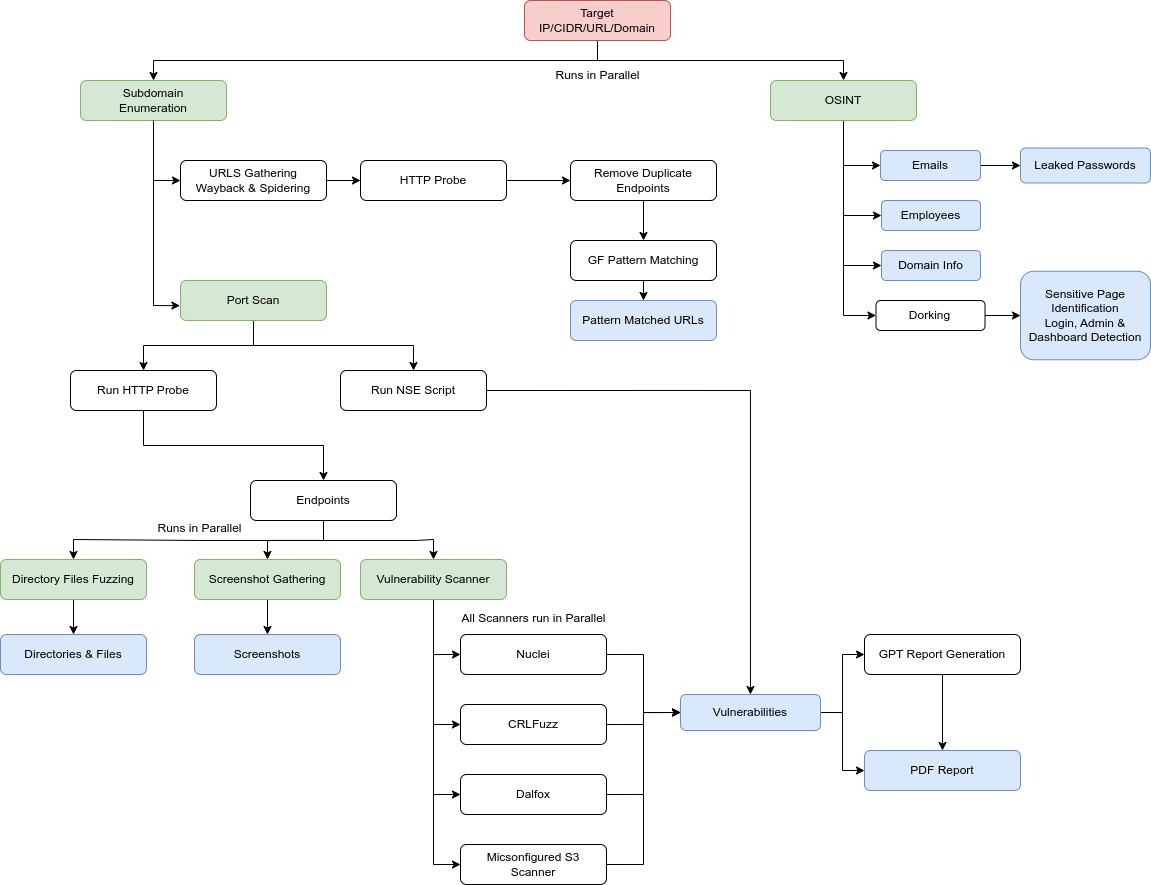
Features
- Reconnaissance:
- Subdomain Discovery
- IP and Open Ports Identification
- Endpoints Discovery
- Directory/Files fuzzing
- Screenshot Gathering
- Vulnerability Scan
- Nuclei
- Dalfox XSS Scanner
- CRLFuzzer
- Misconfigured S3 Scanner
- WHOIS Identification
- WAF Detection
- OSINT Capabilities
- Meta info Gathering
- Employees Gathering
- Email Address gathering
- Google Dorking for sensitive info and urls
- Projects, create distinct project spaces, each tailored to a specific purpose, such as personal bug bounty hunting, client engagements, or any other specialized recon task.
- Perform Advanced Query lookup using natural language alike and, or, not operations
- Highly configurable YAML-based Scan Engines
- Support for Parallel Scans
- Support for Subscans
- Recon Data visualization
- GPT Vulnerability Description, Impact and Remediation generation
- GPT Attack Surface Generator
- Multiple Roles and Permissions to cater a team's need
- Customizable Alerts/Notifications on Slack, Discord, and Telegram
- Automatically report Vulnerabilities to HackerOne
- Recon Notes and Todos
- Clocked Scans (Run reconnaissance exactly at X Hours and Y minutes) and Periodic Scans (Runs reconnaissance every X minutes/- hours/days/week)
- Proxy Support
- Screenshot Gallery with Filters
- Powerful recon data filtering with autosuggestions
- Recon Data changes, find new/removed subdomains/endpoints
- Tag targets into the Organization
- Smart Duplicate endpoint removal based on page title and content length to cleanup the reconnaissance data
- Identify Interesting Subdomains
- Custom GF patterns and custom Nuclei Templates
- Edit tool-related configuration files (Nuclei, Subfinder, Naabu, amass)
- Add external tools from GitHub/Go
- Interoperable with other tools, Import/Export Subdomains/Endpoints
- Import Targets via IP and/or CIDRs
- Report Generation
- Toolbox: Comes bundled with most commonly used tools during penetration testing such as whois lookup, CMS detector, CVE lookup, etc.
- Identification of related domains and related TLDs for targets
- Find actionable insights such as Most Common Vulnerability, Most Common CVE ID, Most Vulnerable Target/Subdomain, etc.
- You can now use local LLMs for Attack surface identification and vulnerability description (NEW: reNgine 2.1.0)
Scan Engine
# Global vars for all tools
#
# custom_headers: ['Foo: bar', 'User-Agent: Anything'] # FFUF, Nuclei, Dalfox, CRL Fuzz, HTTP Crawl, Fetch URL, etc
# enable_http_crawl: true # All tools
# threads: 30 # All tools
subdomain_discovery: {
'uses_tools': ['subfinder', 'ctfr', 'sublist3r', 'tlsx', 'oneforall', 'netlas'], # amass-passive, amass-active, All
'enable_http_crawl': true,
'threads': 30,
'timeout': 5,
# 'use_subfinder_config': false,
# 'use_amass_config': false,
# 'amass_wordlist': 'deepmagic.com-prefixes-top50000'
}
http_crawl: {
# 'threads': 30,
# 'follow_redirect': true
}
port_scan: {
'enable_http_crawl': true,
'timeout': 5,
# 'exclude_ports': [],
# 'exclude_subdomains': [],
'ports': ['top-100'],
'rate_limit': 150,
'threads': 30,
'passive': false,
# 'use_naabu_config': false,
# 'enable_nmap': true,
# 'nmap_cmd': '',
# 'nmap_script': '',
# 'nmap_script_args': ''
}
osint: {
'discover': [
'emails',
'metainfo',
'employees'
],
'dorks': [
'login_pages',
'admin_panels',
'dashboard_pages',
'stackoverflow',
'social_media',
'project_management',
'code_sharing',
'config_files',
'jenkins',
'wordpress_files',
'php_error',
'exposed_documents',
'db_files',
'git_exposed'
],
# 'custom_dorks': [],
'intensity': 'normal',
'documents_limit': 50
}
dir_file_fuzz: {
'auto_calibration': true,
'enable_http_crawl': true,
'rate_limit': 150,
'extensions': ['html', 'php','git','yaml','conf','cnf','config','gz','env','log','db','mysql','bak','asp','aspx','txt','conf','sql','json','yml','pdf'],
'follow_redirect': false,
'max_time': 0,
'match_http_status': [200, 204],
'recursive_level': 2,
'stop_on_error': false,
'timeout': 5,
'threads': 30,
'wordlist_name': 'dicc'
}
fetch_url: {
'uses_tools': ['gospider', 'hakrawler', 'waybackurls', 'katana', 'gau'],
'remove_duplicate_endpoints': true,
'duplicate_fields': ['content_length', 'page_title'],
'enable_http_crawl': true,
'gf_patterns': ['debug_logic', 'idor', 'interestingEXT', 'interestingparams', 'interestingsubs', 'lfi', 'rce', 'redirect', 'sqli', 'ssrf', 'ssti', 'xss'],
'ignore_file_extensions': ['png', 'jpg', 'jpeg', 'gif', 'mp4', 'mpeg', 'mp3'],
'threads': 30,
# 'exclude_subdomains': false
}
vulnerability_scan: {
'run_nuclei': true,
'run_dalfox': false,
'run_crlfuzz': false,
'run_s3scanner': false,
'enable_http_crawl': true,
'concurrency': 50,
'intensity': 'normal',
'rate_limit': 150,
'retries': 1,
'timeout': 5,
'fetch_gpt_report': true,
'nuclei': {
'use_nuclei_config': false,
'severities': ['unknown', 'info', 'low', 'medium', 'high', 'critical'],
# 'tags': [], # Nuclei tags (https://github.com/projectdiscovery/nuclei-templates)
# 'templates': [], # Nuclei templates (https://github.com/projectdiscovery/nuclei-templates)
# 'custom_templates': [] # Nuclei custom templates uploaded in reNgine
}
}
waf_detection: {
'enable_http_crawl': true
}
screenshot: {
'enable_http_crawl': true,
'intensity': 'normal',
'timeout': 10,
'threads': 40
}
Quick Installation
Quick Setup for Ubuntu/VPS
- Clone the repositorygit clone https://github.com/yogeshojha/rengine && cd rengine
- Configure the environmentnano .envEnsure you change the
POSTGRES_PASSWORDfor security. - (Optional) For non-interactive install, set admin credentials in
.envDJANGO_SUPERUSER_USERNAME=yourUsername
DJANGO_SUPERUSER_EMAIL=YourMail@example.com
DJANGO_SUPERUSER_PASSWORD=yourStrongPasswordIf you need to carry out a non-interactive installation, you can setup the login, email and password of the web interface admin directly from the .env file (instead of manually setting them from prompts during the installation process). This option can be interesting for automated installation (via ansible, vagrant, etc.).DJANGO_SUPERUSER_USERNAME: web interface admin username (used to login to the web interface).DJANGO_SUPERUSER_EMAIL: web interface admin email.DJANGO_SUPERUSER_PASSWORD: web interface admin password (used to login to the web interface).
- Adjust Celery worker scaling in
.envMAX_CONCURRENCY=80
MIN_CONCURRENCY=10MAX_CONCURRENCY: This parameter specifies the maximum number of reNgine's concurrent Celery worker processes that can be spawned. In this case, it's set to 80, meaning that the application can utilize up to 80 concurrent worker processes to execute tasks concurrently. This is useful for handling a high volume of scans or when you want to scale up processing power during periods of high demand. If you have more CPU cores, you will need to increase this for maximised performance.MIN_CONCURRENCY: On the other hand, MIN_CONCURRENCY specifies the minimum number of concurrent worker processes that should be maintained, even during periods of lower demand. In this example, it's set to 10, which means that even when there are fewer tasks to process, at least 10 worker processes will be kept running. This helps ensure that the application can respond promptly to incoming tasks without the overhead of repeatedly starting and stopping worker processes.These settings allow for dynamic scaling of Celery workers, ensuring that the application efficiently manages its workload by adjusting the number of concurrent workers based on the workload's size and complexity.Here is the ideal value forMIN_CONCURRENCYandMAX_CONCURRENCYdepending on the number of RAM your machine has:This is just an ideal value which developers have tested and tried out and works! But feel free to play around with the values. Maximum number of scans is determined by various factors, your network bandwidth, RAM, number of CPUs available. etc- 4GB:
MAX_CONCURRENCY=10 - 8GB:
MAX_CONCURRENCY=30 - 16GB:
MAX_CONCURRENCY=50
- 4GB:
- Run the installation script:sudo ./install.shFor non-interactive install:
sudo ./install.sh -nNote: If needed, runchmod +x install.shto grant execution permissions.
reNgine can now be accessed from https://127.0.0.1 or if you're on the VPS https://your_vps_ip_address
Unless you are on development branch, please do not access reNgine via any ports
Installation on Other Platforms
For Mac, Windows, or other systems, refer to our detailed installation guide https://reNgine.wiki/install/detailed/
Updating
- To update reNgine, run:cd rengine && sudo ./update.shIf
update.shlacks execution permissions, use:sudo chmod +x update.sh
Changelog
For the latest updates and changes, please check our changelog.
Screenshots
Scan Results

General Usage

Initiating Subscan

Recon Data filtering

Report Generation

Toolbox

Adding Custom tool in Tools Arsenal
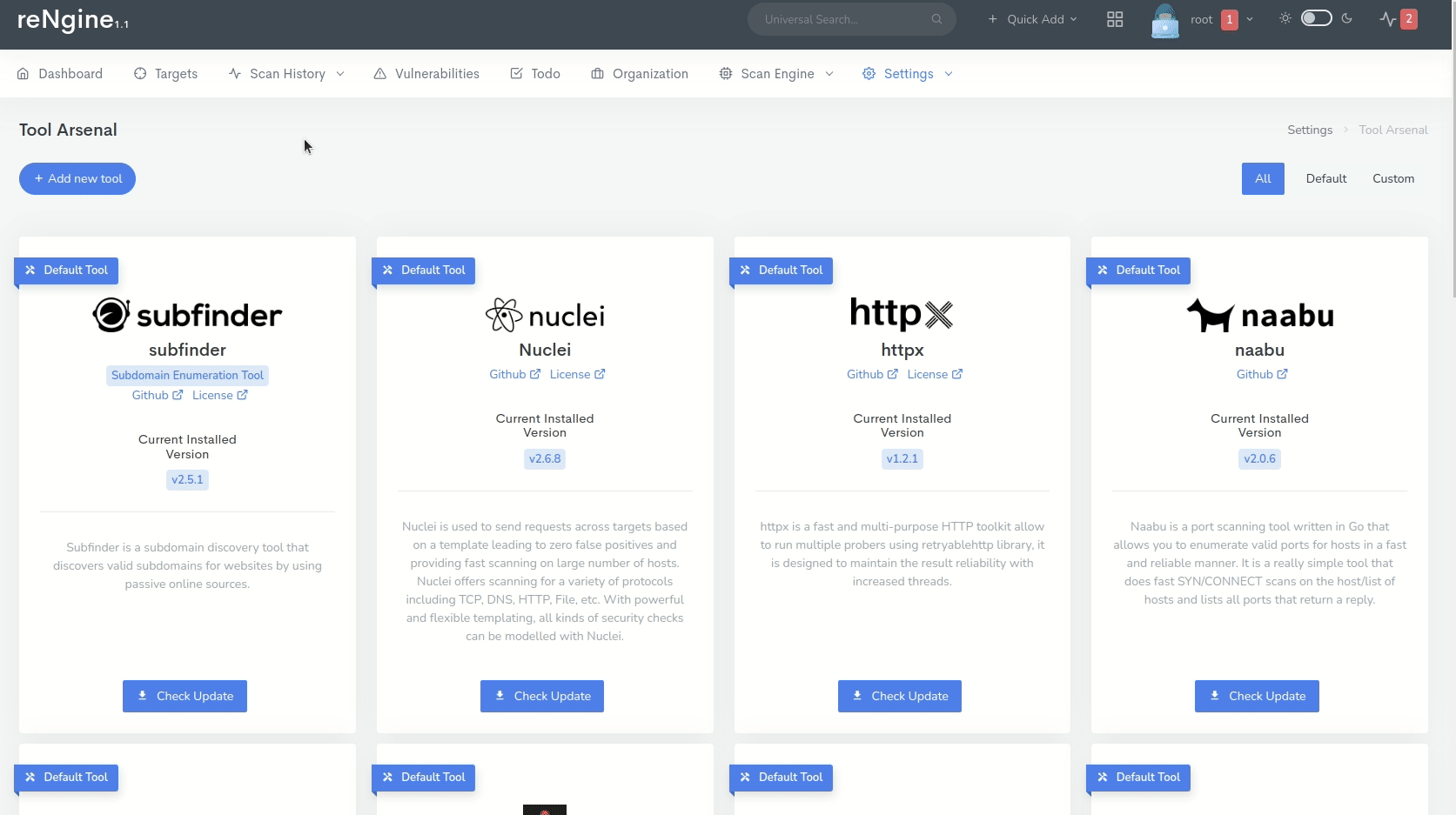
Contributing
We welcome contributions of all sizes! The open-source community thrives on collaboration, and your input is invaluable. Whether you're fixing a typo, improving UI, or adding new features, every contribution matters.
How you can contribute:
- Code improvements
- Documentation updates
- Bug reports and fixes
- New feature suggestions and implementations
- UI/UX enhancements
To get started:
- Check our Contributing Guide
- Pick an open issue or propose a new one
- Fork the repository and create your branch
- Make your changes and submit a pull request
Remember, no contribution is too small. Your efforts help make reNgine better for everyone!
Submitting issues
When submitting issues, provide as much valuable information as possible to help developers resolve the problem quickly. Follow these steps to gather detailed debug information:
- Enable Debug Mode:
- Edit
web/entrypoint.shin the project root - Add
export DEBUG=1at the top of the file:#!/bin/bash
export DEBUG=1
python3 manage.py migrate
python3 manage.py runserver 0.0.0.0:8000
exec "$@" - Restart the web container:
docker-compose restart web
- Edit
- View Debug Output:
- Run
make logsto see the full stack trace - Check the browser's developer console for XHR requests with 500 errors
- Run
- Submit Your Issue:
- Include the full stack trace in your GitHub issue
- Describe the steps to reproduce the problem
- Mention any relevant system information
- Disable Debug Mode:
- Set
DEBUG=0inweb/entrypoint.sh - Restart the web container
- Set
Example Debug Output:
web_1 | File "/usr/local/lib/python3.10/dist-packages/celery/app/task.py", line 411, in __call__
web_1 | return self.run(*args, **kwargs)
web_1 | TypeError: run_command() got an unexpected keyword argument 'echo'
By providing this detailed information, you significantly help developers identify and fix issues more efficiently.
First-time Open Source contributors
reNgine is an open-source project that welcomes contributors of all experience levels, including beginners. If you've never contributed to open source before, we encourage you to start here!
- We're proud to support your first Pull Request (PR)
- Check our open issues for starter-friendly tasks
- Don't hesitate to ask questions in our community channels
Your contribution, no matter how small, is valuable to us.
reNgine Support
Before seeking support:
- Please carefully read the README and documentation at rengine.wiki.
- Most common questions and issues are addressed there.
If you still need assistance:
- Do not use GitHub issues for support requests.
- Join our community-maintained Discord channel.
Please note:
- The Discord channel is maintained by the community.
- While we strive to help, there's no guarantee of support or response time.
- For confirmed bugs or feature requests, consider opening a GitHub issue.
Support and Sponsoring
reNgine is a passion project developed in my free time, alongside my day job. Your support helps keep this project alive and growing. Here's how you can contribute:
- Add a GitHub Star to the project.
- Share about reNgine on social media or in blog posts
- Nominate me for GitHub Stars?
- Use my DigitalOcean referral link to get $100 credit (I receive $25)
Your support, whether through donations or simply giving a star, tells me that reNgine is valuable to you. It motivates me to continue improving and adding features to make reNgine the go-to tool for reconnaissance.
Thank you for your support!
License
Distributed under the GNU GPL v3 License. See LICENSE for more information.
Reporting Security Vulnerabilities
We appreciate your efforts to responsibly disclose your findings and will make every effort to acknowledge your contributions.
To report a security vulnerability, please follow these steps:
- Do Not disclose the vulnerability publicly on GitHub issues or any other public forum.
- Go to the Security tab of the reNgine repository.
- Click on "Report a vulnerability" to open GitHub's private vulnerability reporting form.
- Provide a detailed description of the vulnerability, including:
- Steps to reproduce
- Potential impact
- Any suggested fixes or mitigations (if you have them)
- I will review your report and respond as quickly as possible, usually within 48-72 hours.
- Please allow some time to investigate and address the vulnerability before disclosing it to others.
We are committed to working with security researchers to verify and address any potential vulnerabilities reported to us. After fixing the issue, we will publicly acknowledge your responsible disclosure, unless you prefer to remain anonymous.
Thank you for helping to keep reNgine and its users safe!


